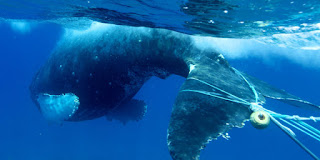1. Shark Fins Sold in Canada Include Endangered Species
 Genetic testing of 71 shark fins purchased in Canada found specimens from seven species “considered at risk of extinction.” Some were from the whale shark, the largest fish in the ocean. Manta and mobulid ray gill plates purchased in China and Sri Lanka also included endangered species. Seven shark species and five ray species found are on the banned list from CITES (Convention on International Trade in Endangered Species).
Genetic testing of 71 shark fins purchased in Canada found specimens from seven species “considered at risk of extinction.” Some were from the whale shark, the largest fish in the ocean. Manta and mobulid ray gill plates purchased in China and Sri Lanka also included endangered species. Seven shark species and five ray species found are on the banned list from CITES (Convention on International Trade in Endangered Species).
-----------------------------------------------
2. Sustainability of World’s Biggest Tuna Fishery Questioned
 Skipjack tuna from the western and central Pacific Ocean are not always sustainably caught, despite the fishery being certified by the Marine Stewardship Council (MSC). Skipjack tuna from this region make up half of the tuna on the supermarket shelves. Boats certified by MSC are permitted to catch uncertified fish using unsustainable means at other times, according to a British consumer coalition.
Read More...
Skipjack tuna from the western and central Pacific Ocean are not always sustainably caught, despite the fishery being certified by the Marine Stewardship Council (MSC). Skipjack tuna from this region make up half of the tuna on the supermarket shelves. Boats certified by MSC are permitted to catch uncertified fish using unsustainable means at other times, according to a British consumer coalition.
Read More...
3. Scientists Asked to Scrub References to Climate Change in their Grants2. Sustainability of World’s Biggest Tuna Fishery Questioned
 Skipjack tuna from the western and central Pacific Ocean are not always sustainably caught, despite the fishery being certified by the Marine Stewardship Council (MSC). Skipjack tuna from this region make up half of the tuna on the supermarket shelves. Boats certified by MSC are permitted to catch uncertified fish using unsustainable means at other times, according to a British consumer coalition.
Skipjack tuna from the western and central Pacific Ocean are not always sustainably caught, despite the fishery being certified by the Marine Stewardship Council (MSC). Skipjack tuna from this region make up half of the tuna on the supermarket shelves. Boats certified by MSC are permitted to catch uncertified fish using unsustainable means at other times, according to a British consumer coalition.
-----------------------------------------------
 In their grants with the U.S. Department of Energy, scientists have been asked to scrub all references to global warming and climate change as part of the Trump administration’s “budget language restrictions.” One scientist says he "is more concerned that research priorities are being set by political ideology that is at odds with scientific knowledge.”
In their grants with the U.S. Department of Energy, scientists have been asked to scrub all references to global warming and climate change as part of the Trump administration’s “budget language restrictions.” One scientist says he "is more concerned that research priorities are being set by political ideology that is at odds with scientific knowledge.”-----------------------------------------------
 In 2016, 71 whales were seen entangled in fishing gear, another record year. Less than a dozen of those caught were actually freed from the fishing gear. Some of the gear was from the dungeness crab fishery. The Center for Biological Diversity filed a notice of intent to the California Department of Fish and Wildlife saying they are violating the Endangered Species Act for “failing to protect endangered whales and sea turtles.”
In 2016, 71 whales were seen entangled in fishing gear, another record year. Less than a dozen of those caught were actually freed from the fishing gear. Some of the gear was from the dungeness crab fishery. The Center for Biological Diversity filed a notice of intent to the California Department of Fish and Wildlife saying they are violating the Endangered Species Act for “failing to protect endangered whales and sea turtles.”
-----------------------------------------------
5. Ocean Fog Carries Mercury to Land
 Scientists in the Monterey Bay and Santa Cruz regions of California have found that ocean fog carries mercury (a heavy metal and neurotoxin) to land. They measured mercury levels in fog, water, plants and animals. They found 10 times more mercury in the fog than in rainfall. The mercury mainly comes from gold mining and coal-fired power plants.
Scientists in the Monterey Bay and Santa Cruz regions of California have found that ocean fog carries mercury (a heavy metal and neurotoxin) to land. They measured mercury levels in fog, water, plants and animals. They found 10 times more mercury in the fog than in rainfall. The mercury mainly comes from gold mining and coal-fired power plants.-----------------------------------------------
Be sure to "LIKE" http://facebook.com/SeaSave to ensure our "Week in Review" is delivered to your newsfeed every Friday.
Sea Save Foundation is committed to raising awareness of marine conservation. The Week in Review is a team effort produced by the Sea Save staff to provide a weekly summary of the latest in marine research, policy, and news.